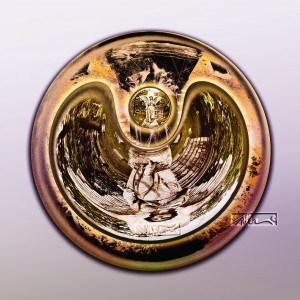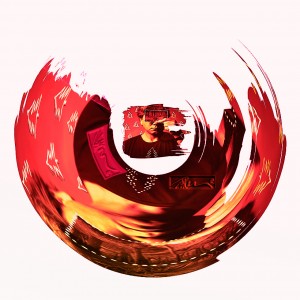Secret Images – Cool Anamorphic Photo Distortions and Perspective Illusions
The concept of anamorphic imagery dates back to the days of the Renaissance. Michelangelo may have invented it. There are many different forms and methods for creating morphed imagery. The Victorian period used it for concealing and viewing images hidden in paintings.
The Anamorphic image was invented during a time when artists were studying natural perspective. Natural perspective is how we see the world. We have references in nature that tell us things about distance and shape. In linear perspective, the horizon depicts infinity and other lines recede towards the horizon as things diminish in scale due to distance from the viewer.
Anamorphic images are image perspectives that have been altered either to accommodate a surface, for an illusionary effect, or for some other reason.
Usually, anamorphic images are meant to be viewable from a single viewpoint. The paintings in the Sistine Chapel in Rome can be seen in their best and fullest form from such a point. Domes in ceilings and other architectural forms, allow for a variety of visual effects.
Anamorphic imagery is a distortion of natural perspective until the viewer lines up with the painted view angle. Shaped forms such as cones, cylinders, balls and other non-flat surfaces require different types of mutated painting. In most situations, the artist is required to paint from the viewing position or at least monitor what was being imaged from that position during the process.
The Chrysler building in New York uses a type of anamorphic, which combines different elements, located at different heights. The image completes a winged eagle, which can only be properly viewed from a corner and from the ground looking upwards. The wings at a lower level line up and scale perfectly with the head that is at a higher elevation.
There are cameras that have been produced to create anamorphic imagery. Pinhole anamorphic cameras are probably the most common.
One of my favorite methods of producing an anamorphic image utilizes a mirrored tube. The column of which reflects the distorted image so that it is corrected and made viewable as a mirror image. The method is sometimes referred to as a mirrored anamorphic.
Both painters and photographers have produced modern versions of anamorphic imagery. Below, you will find a contemporary artist who produces 3 dimensional sculptural anamorphic images that are absolutely amazing. Lately, I have seen images of collected objects that transform into amazing shadows.
Personally, I think they are all amazing.
The images shown on this page are a few of my own reflective anamorphic photographs employing a number of methods from my book. The images were created with both digital and film imagery.
These anamorphic images are difficult to see on a computer because you need a reflective tube to view the reflection. I have included an approximation of the reflection in the examples. Hopefully you should get a good idea of the concepts from the videos below.
Anamorphic images are a fun alternative to rectangular imagery. They are fascinating and can be very mysterious as well.
Here are some links to show a few other illusions that might inspire and amaze:
<iframe width=”640″ height=”360″ src=”//www.youtube.com/embed/UelJZG_bF98?rel=0″ frameborder=”0″ allowfullscreen></iframe>
<iframe width=”480″ height=”360″ src=”//www.youtube.com/embed/qQ1AWAzJEH8?rel=0″ frameborder=”0″ allowfullscreen></iframe>
I cover many photographic topics and techniques in my book. – Great Photography Gift Idea for any Photographer.
Please have a look at some of my other posts here.
NOTICE of Copyright: THIS POSTING AS WELL AS ALL PHOTOGRAPHS, GALLERY IMAGES, AND ILLUSTRATIONS ARE COPYRIGHT © JOHN NEEL AND ARE NOT TO BE USED FOR ANY PURPOSE WITHOUT WRITTEN CONSENT FROM THE WRITER, THE PHOTOGRAPHER AND/OR lensgarden.com. THE IDEAS EXPRESSED ARE THE PROPERTY OF THE PHOTOGRAPHER AND THE AUTHOR.







Caro John,complimenti per il tuo capolavoro Anamorphic foto,come posso fare la mia faccia Anamorphica e quale Sotware devo usare,spero che mi aiuti.
Aspetto la tua risposta grazie
Codiali saluti
Francesco
Francesco – Soon, I hope to write a post that will explain how it is done. I use Photoshop to create the morph. I’ll try to have something within the next week or so. – John